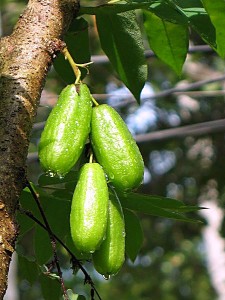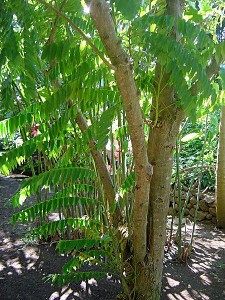 Averrhoa bilimbi, bimbli, belimbing, blimbling, biling commonly known as Kamias in the Philippines is a close relative of the carambola, of genus Averrhoa, family Oxalidaceae. The bilimbi is ellipsoid, obovoid or nearly cylindrical, capped by a thin, star-shaped calyx at the stem-end and tipped with 5 hair-like floral remnants at the apex. The fruit is crisp when unripe, turns from bright-green to yellowish-green, ivory or nearly white when ripe and falls to the ground. The outer skin is glossy, very thin, soft and tender, and the flesh green, jelly-like, juicy and extremely acid. There may be a few (perhaps 6 or 7) flattened, disc-like seeds about 1/4 in (6 mm) wide, smooth and brown.
Averrhoa bilimbi, bimbli, belimbing, blimbling, biling commonly known as Kamias in the Philippines is a close relative of the carambola, of genus Averrhoa, family Oxalidaceae. The bilimbi is ellipsoid, obovoid or nearly cylindrical, capped by a thin, star-shaped calyx at the stem-end and tipped with 5 hair-like floral remnants at the apex. The fruit is crisp when unripe, turns from bright-green to yellowish-green, ivory or nearly white when ripe and falls to the ground. The outer skin is glossy, very thin, soft and tender, and the flesh green, jelly-like, juicy and extremely acid. There may be a few (perhaps 6 or 7) flattened, disc-like seeds about 1/4 in (6 mm) wide, smooth and brown.
This is essentially a tropical tree, less resistant to cold than the carambola, growing best in rich and well-drained soil (but also stands limestone and sand). It prefers evenly distributed rainfall throughout the year, but with a 2- to 3-month dry season. The bilimbi tree is long-lived and reaches 5-10 m in height. Its trunk is short and quickly divides up into ramifications. Bilimbi leaves, 3-6 cm long, are alternate, imparipinnate and cluster at branch extremities. There are around 11 to 37 alternate or subopposite oblong leaflets.
There are few cultivated varieties of bilimbi. However, there a sweet variety in the Philippines- where the sour bilimbis are called “kamias”,while the sweet variety is called “balimbing”. It is commonly found as a backyard plant, it is eaten either raw or dipped in rock salt (or other savoury powders – masala), as a snack. It could either be curried or added as flavoring for the common Filipino dish like sinigang. The leaves serve as a paste on itches, swelling, rheumatism, mumps or skin eruptions. Elsewhere, they are used for bites of poisonous creatures. A leaf infusion is efficient against or as an after-birth tonic, while the flower infusion is used for thrush, cold, and cough. Malaysians use fermented or fresh bilimbi leaves to cure venereal diseases.
Production of Kamias
Origin and Distribution
Perhaps a native of the Moluccas, the bilimbi is cultivated throughout Indonesia; is cultivated and semi-wild everywhere in the Philippines; is much grown in Ceylon and Burma. It is very common in Thailand, Malaya and Singapore; frequent in gardens across the plains of India, and has run wild in all the warmest areas of that country.
Varieties
Kamias are all much the same wherever they are grown, but P.J. Wester reported that a form with sweet fruits had been discovered in the Philippines. It is called Balimbing.
Climate
Kamias is a tropical species, it needs protection from cold and wind. Ideally, rainfall should be rather evenly distributed throughout most of the year but there should be a 2- to 3-month dry season. The tree makes slow growth in shady or semi-shady situations. It should be in full sun.
Soil
While kamias does best in rich, moist, but well-drained soil, it grows and fruits quite well on sand or limestone.

Propagation
Most efforts at grafting and budding have not been rewarding, though Wester had success in shield-budding, utilizing non-petioled, ripe, brown budwood cut 1 1/2 to 2 in (3.8-5 cm) long. Air-layering has been practiced in Indonesia for many years. However, the tree is more widely grown from seed. Kamias trees are vigorous and receive no special horticultural attention. It has been suggested that they would respond well to whatever cultural treatment.
Harvesting and Keeping Quality
The fruits are picked by hand, singly or in clusters. They need gentle handling because of the thin skin. They cannot be kept on hand for more than a few days.
- Parts utilized – Whole plant.
- Properties – Considered antibacterial, astringent, antiscorbutic, febrifuge, antidiabetic, stomachic, refrigerant.
- Season, Harvesting and Keeping Quality – The tree begins to flower about February and then blooms and fruits more or less continuously until December. The fruits are picked by hand, singly or in clusters. They need gentle handling because of the thin skin. They cannot be kept on hand for more than a few days.
Pests and Diseases
No pests or diseases have been reported specifically for the bilimbi.
Food Uses
Kamias is generally regarded as too acid for eating raw, but in Costa Rica, the green, uncooked fruits are prepared as a relish which is served with rice and beans. Sometimes it is an accompaniment for fish and meat. Ripe fruits are frequently added to curries in the Far East. They yield 44.2% juice having a pH of 4.47, and the juice is popular for making cooling beverages on the order of lemonade.
To reduce acidity, it may be first pricked and soaked in water overnight, or soaked in salted water for a shorter time; then it is boiled with much sugar to make a jam or an acid jelly. Half-ripe fruits are salted, set out in the sun, and pickled in brine and can be thus kept for 3 months. A quicker pickle is made by putting the fruits and salt into boiling water. This product can be kept only 4 to 5 days.
The flowers are sometimes preserved with sugar.
Food Value Per 100 g of Edible Portion
- Moisture 94.2-94.7 g
- Protein 0.61 g
- Fiber 0.6g
- Ash 0.31-0.40 g
- Calcium 3.4 mg
- Phosphorus 11.1 mg
- Iron 1.01 mg
- Carotene 0.035 mg
- Thiamine 0.010 mg
- Riboflavin 0.026 mg
- Niacin 0.302 mg
- Ascorbic Acid 15.5 mg
Note : According to analysis of fruits studied in Nicaragua and the Philippines.
Other Uses
- Fruit: Very acid kamias are employed to clean the blade of a kris (dagger), and they serve as mordants in the preparation of an orange dye for silk fabrics. Kamias juice, because of its oxalic acid content, is useful for bleaching stains from the hands and rust from white cloth, and also tarnish from brass.
- Wood: The wood is white, soft but tough, even-grained, and weighs 35 lbs/cu ft. It is seldom available for carpentry.
- Medicinal Uses: In the Philippines, the leaves are applied as a paste or poultice on itches, swellings of mumps and rheumatism, and on skin eruptions. Elsewhere, they are applied on bites of poisonous creatures. Malayans take the leaves fresh or fermented as a treatment for venereal disease. A leaf infusion is a remedy for coughs and is taken after childbirth as a tonic. A leaf decoction is taken to relieve rectal inflammation. A flower infusion is said to be effective against coughs and thrush.
Traditional Uses “Folkloric Uses”
- Skin diseases, especially with pruritus: Reduce the leaves to a paste and apply tolerably warm to areas of affected skin.
- Post-partum and rectal inflammation: Infusion of leaves.
- Mumps, acne, and localized rheumatic complaints: Paste of leaves applied to affected areas.
- Warm paste of leaves also used for pruritus.
- Cough and thrush: Infusion of flowers, 40 grams to a pint of boiling water, 4 glasses of tea daily.
- Fever: Fruit as a cooling drink.
- The fruit has been used for a variety of maladies: beriberi, cough, prevention of scurvy.
- Infusion of leaves also drank as a protective tonic after childbirth.
- In Malaysia, leaves are used for venereal diseases.
- In Indonesia, leaves used for boils, diabetes, mumps, fever.
- In French Guyana, fruit decoction or syrup use for hepatitis, diarrhea, fever and other inflammatory conditions.
- Because of high oxalic acid content, fruit used to remove stains from clothing and for washing hands, removing rust and stains from metal blades.
Studies
- Effects of Averrhoa bilimbi leaf extract on blood glucose and lipids in streptozotocin-diabetic rats: Study showed that AB extract has hypoglycemic, hypotriglyceridemic, anti-lipid peroxidative and anti-atherogenic properties in STZ-diabetic rats.
- Antioxidant And Antimicrobial Activities Of Averrhoa carambola L. Fruits: The scavenging of NO by the extract was dependent on concentration and stage of ripening. Extracts showed antimicrobial activity against E coli, Salmonella typhi, staph aureus and bacillus cereus.
Sources: stuartxchange.org; Photos: wikipedia
Hi, Can you produce 5tons of kamias monthly?